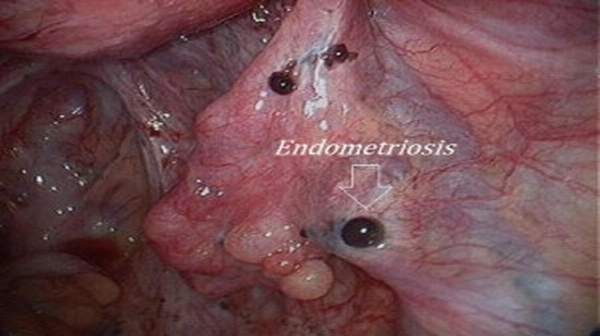What's in this article?
What is Endometriosis
Endometriosis (en-doe-me-tree-O-sis) is an often painful disorder in which tissue that normally lines the inside of your uterus the endometrium grows outside your uterus (endometrial implant). Endometriosis most commonly involves your ovaries, bowel or the tissue lining your pelvis. Rarely, endometrial tissue may spread beyond your pelvic region.
In endometriosis, displaced endometrial tissue continues to act as it normally would it thickens, breaks down and bleeds with each menstrual cycle. Because this displaced tissue has no way to exit your body, it becomes trapped. When endometriosis involves the ovaries, cysts called endometriomas may form. Surrounding tissue can become irritated, eventually developing scar tissue and adhesions abnormal tissue that binds organs together.
Endometriosis facts
- Endometriosis is the abnormal growth of cells (endometrial cells) similar to those that form the inside of the uterus, but in a location outside of the uterus. Endometriosis is most commonly found on other organs of the pelvis.
- The exact cause of endometriosis has not been identified.
- Endometriosis is more common in women who are experiencing infertility than in fertile women, but the condition does not necessarily cause infertility.
- Most women with endometriosis have no symptoms, in which case therapy is neither appropriate nor necessary.
- Pelvic pain during menstruation or ovulation can be a symptom of endometriosis, but may also occur in normal women.
- Endometriosis can be suspected based on the woman’s pattern of symptoms, and sometimes during a physical examination, but the definite diagnosis is confirmed by surgery, usually laparoscopy.
- Treatment of endometriosis includes medication and surgery for both pain relief and treatment of infertility if pregnancy is desired.
Symptoms of Endometriosis
The primary symptom of endometriosis is pelvic pain, often associated with your menstrual period. Although many women experience cramping during their menstrual period, women with endometriosis typically describe menstrual pain that’s far worse than usual. They also tend to report that the pain has increased over time.
Common signs and symptoms of endometriosis may include:
- Painful periods (dysmenorrhea). Pelvic pain and cramping may begin before and extend several days into your period and may include lower back and abdominal pain.
- Pain with intercourse. Pain during or after sex is common with endometriosis.
- Pain with bowel movements or urination. You’re most likely to experience these symptoms during your period.
- Excessive bleeding. You may experience occasional heavy periods (menorrhagia) or bleeding between periods (menometrorrhagia).
- Infertility. Endometriosis is first diagnosed in some women who are seeking treatment for infertility.
- Other symptoms. You may also experience fatigue, diarrhea, constipation, bloating or nausea, especially during menstrual periods.
The severity of your pain isn’t necessarily a reliable indicator of the extent of the condition. Some women with mild endometriosis have extensive pain, while others with advanced endometriosis may have little pain or even no pain at all.
Endometriosis is sometimes mistaken for other conditions that can cause pelvic pain, such as pelvic inflammatory disease (PID) or ovarian cysts. It may be confused with irritable bowel syndrome (IBS), a condition that causes bouts of diarrhea, constipation and abdominal cramping. IBS can accompany endometriosis, which can complicate the diagnosis.
Who is affected by endometriosis?
Endometriosis affects women in their reproductive years. The exact prevalence of endometriosis is not known, since many women may have the condition and have no symptoms. Endometriosis is estimated to affect over one million women (estimates range from 3% to 18% of women) in the United States. It is one of the leading causes of pelvic pain and reasons for laparoscopic surgery and hysterectomy in this country. Estimates suggest that between 20% to 50% of women being treated for infertility have endometriosis, and up to 80% of women with chronic pelvic pain may be affected.
While most cases of endometriosis are diagnosed in women aged around 25 to 35 years, endometriosis has been reported in girls as young as 11 years of age. Endometriosis is rare in postmenopausal women. Endometriosis is more commonly found in white women as compared with African American and Asian women. Studies further suggest that endometriosis is most common in taller, thin women with a low body mass index (BMI). Delaying pregnancy until an older age is also believed to increase the risk of developing endometriosis. It also is likely that there are genetic factors that predispose a woman to developing endometriosis, since having a first-degree relative with the condition increases the chance that a woman will develop the condition.
Causes of Endometriosis
Although the exact cause of endometriosis is not certain, several possible explanations include:
♦ Retrograde menstruation. This is the most likely explanation for endometriosis. In retrograde menstruation, menstrual blood containing endometrial cells flows back through the fallopian tubes and into the pelvic cavity instead of out of the body. These displaced endometrial cells stick to the pelvic walls and surfaces of pelvic organs, where they grow and continue to thicken and bleed over the course of each menstrual cycle.
♦ Embryonic cell growth. The cells lining the abdominal and pelvic cavities come from embryonic cells. When one or more small areas of the abdominal lining turn into endometrial tissue, endometriosis can develop.
♦ Surgical scar implantation. After a surgery, such as a hysterectomy or C-section, endometrial cells may attach to a surgical incision.
♦ Endometrial cells transport. The blood vessels or tissue fluid (lymphatic) system may transport endometrial cells to other parts of the body.
♦ Immune system disorder. It’s possible that a problem with the immune system may make the body unable to recognize and destroy endometrial tissue that’s growing outside the uterus.





